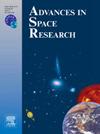Evaluation and improvement of the Sentinel-3 Ku band backscatter coefficient atmospheric attenuation correction over the open ocean
IF 2.8
3区 地球科学
Q2 ASTRONOMY & ASTROPHYSICS
引用次数: 0
Abstract
The presence of water vapor and cloud liquid water in the Earth’s atmosphere induces an attenuation in satellite altimeters backscatter coefficient (σ0) measurements. To account for this effect, an atmospheric attenuation correction, Δσ0, is added to the measured σ0. The focus of this study is the assessment and improvement over open ocean of the Sentinel-3 Synthetic Aperture Radar Altimeter (SRAL) Ku band Δσ0, operationally computed from Microwave Radiometer (MWR) measurements and the uncorrected SRAL σ0. In a first phase, comparisons are performed against the Jason-3 Ku band Δσ0 and Δσ0 computed from single-layer model grids from the ERA5 atmospheric model. Results show that the Sentinel-3A Δσ0 lacks precision mainly over regions of high atmospheric water vapor content, where the standard deviation of the relative differences to the ERA5 model are 50 % and higher. In a second phase, two new Sentinel-3A Δσ0 algorithms are proposed, a new MWR-derived solution and one computed from the Global Navigation Satellite Systems-derived Path Delay Plus (GPD+) wet tropospheric correction. Results show that, w.r.t. the Sentinel-3A operational algorithm, the developed Δσ0 approaches and the one derived from ERA5 are able to reduce the standard deviation of 10-meter surface wind speed (computed from σ0 corrected for attenuation) differences to 10-meter equivalent neutral winds from the MetOp-B Advanced Scatterometer. The largest reductions are of the order of 0.3 m/s and higher and occur predominantly over regions of high atmospheric water vapor content. Additionally, the new MWR and GPD+ Δσ0 algorithms present the most feasible solutions for operational applications.
Sentinel-3 Ku波段大气衰减校正后向散射系数的评价与改进
地球大气中水蒸气和云液态水的存在导致卫星高度计测量的后向散射系数(σ0)衰减。为了解释这种影响,在测量的σ0中加入大气衰减校正Δσ0。本文重点研究了Sentinel-3合成孔径雷达高度计(SRAL) Ku波段Δσ0在开放海洋上的评估和改进,该波段是由微波辐射计(MWR)测量和未校正的SRAL σ0实际计算得到的。在第一阶段,与ERA5大气模式的单层模式网格计算的Jason-3 Ku波段Δσ0和Δσ0进行比较。结果表明,Sentinel-3A Δσ0主要在大气水汽含量高的区域缺乏精度,与ERA5模式相对差异的标准差在50%以上。在第二阶段,提出了两种新的Sentinel-3A Δσ0算法,一种新的mwr衍生解和一种基于全球导航卫星系统衍生路径延迟加(GPD+)湿对流层校正计算的解。结果表明,在Sentinel-3A运行算法、Δσ0方法和ERA5方法的基础上,可以减小MetOp-B高级散射仪10米等效中性风的10米地面风速差(σ0经衰减校正后计算)的标准差。最大的减少量为0.3 m/s或更高,主要发生在大气水蒸气含量高的地区。此外,新的MWR和GPD+ Δσ0算法为操作应用提供了最可行的解决方案。
本文章由计算机程序翻译,如有差异,请以英文原文为准。
求助全文
约1分钟内获得全文
求助全文
来源期刊

Advances in Space Research
地学天文-地球科学综合
CiteScore
5.20
自引率
11.50%
发文量
800
审稿时长
5.8 months
期刊介绍:
The COSPAR publication Advances in Space Research (ASR) is an open journal covering all areas of space research including: space studies of the Earth''s surface, meteorology, climate, the Earth-Moon system, planets and small bodies of the solar system, upper atmospheres, ionospheres and magnetospheres of the Earth and planets including reference atmospheres, space plasmas in the solar system, astrophysics from space, materials sciences in space, fundamental physics in space, space debris, space weather, Earth observations of space phenomena, etc.
NB: Please note that manuscripts related to life sciences as related to space are no more accepted for submission to Advances in Space Research. Such manuscripts should now be submitted to the new COSPAR Journal Life Sciences in Space Research (LSSR).
All submissions are reviewed by two scientists in the field. COSPAR is an interdisciplinary scientific organization concerned with the progress of space research on an international scale. Operating under the rules of ICSU, COSPAR ignores political considerations and considers all questions solely from the scientific viewpoint.
 求助内容:
求助内容: 应助结果提醒方式:
应助结果提醒方式:


